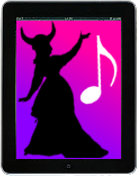Following up on the topic of an earlier post, “Working with music texts, Part 2: Translate the text,” there are times when we need to translate archaic words or spellings that have fallen out of modern usage and are nowadays only encountered in a literary context such as poetry or libretti. Fortunately, there are quite a few websites, apps, and e-books to help with deciphering these bits of antiquated language. Note that several of them are historic dictionaries in the original language, so depending on your level of fluency, you may want to have a translation reference or tool handy for translating the definitions.
Italian
- Florio’s 1611 Italian/English Dictionary: Queen Anna’s New World of Words – You can search the dictionary online or download the entire book as a PDF file. The smaller 1598 edition is available too.
- Zingarelli – Available for iPad/iPhone, Android, and several other mobile and desktop platforms. A web-based version is available for a fee; the first week is free.
- Garzanti Italiano – Register for a free account to search the dictionary on the website. Also available as an app for iPad or iPhone and for desktop platforms as a download or CD-ROM.
- Dizionario Etimologico Online – Search the dictionary online.
- Tesoro della Lingua Italiana delle Origini – Search the dictionary online.
- Archaic Italian Verb Conjugations – Not a dictionary per se, but a useful aid for translation.
- Google Books – Pre-1900 Italian dictionaries here and here (online or downloadable e-book).
French
- A Dictionarie of the French and English Tongues: Compiled by Randle Cotgrave (1611) – You can search the dictionary online or download the entire book as a PDF file.
- Dictionnaires d’autrefois: French dictionaries of the 17th, 18th, 19th and 20th centuries – You can search the set of dictionaries online.
- Garzanti Francese – Register for a free account to search the dictionary on the website. Also available as a CD-ROM.
German
N. B.: I’ve heard that for translating much of the German repertoire, one might have more success using a pre-WWII dictionary that pre-dates the spelling reforms of the mid- to late-20th century.
- Cassell’s German Dictionary – Preferably a pre-war version from the 1930s or earlier. I couldn’t find a digital version anywhere, but I saw this recommended often enough that it deserved special mention. Try your local used bookstore.
- Deutsches Wörterbuch (German Dictionary) by the Brothers Grimm – Free and available online at this website, at Google Books (online or e-book), and at Barnes & Noble as an e-book for NOOK devices and apps (iPad/iPhone, Android, PC, Mac).
- Google Books – Pre-1940 dictionaries here (online or downloadable e-book).
- dict.leo.org – Online German dictionary and language forums.
- dict.cc – Online English-German dictionary with user-contributed definitions; you can also ask the user community your translation questions.
English
If you have any digital resources to add to this list, let me know!
This post was inspired, and much of the information gleaned, from this discussion thread in the archives of the New Forum for Classical Singers. A hat-tip to the folks there who share their expertise.
Related Posts:










